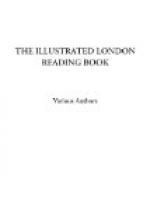This singular variety of the Fox was first made known to naturalists in 1820, after the return of De Laland from South Africa. It is an inhabitant of the mountains in the neighbourhood of the Cape of Good Hope, but it is so rare that little is known of its habits in a state of nature. The Engraving was taken from a specimen which has been lately placed in the Zoological Society’s gardens in the Regent’s Park. It is extremely quick of hearing, and there is something in the general expression of the head which suggests a resemblance to the long-eared bat. Its fur is very thick, and the brush is larger than that of our common European fox. The skin of the fox is in many species very valuable; that of another kind of fox at the Cape of Good Hope is so much in request among the natives as a covering for the cold season, that many of the Bechuanas are solely employed in hunting the animal down with dogs, or laying snares in the places to which it is known to resort.
[Illustration]
In common with all other foxes, those of Africa are great enemies to birds which lay their eggs upon the ground; and their movements are, in particular, closely watched by the ostrich during the laying season. When the fox has surmounted all obstacles in procuring eggs, he has to encounter the difficulty of getting at their contents; but even for this task his cunning finds an expedient, and it is that of pushing them forcibly along the ground until they come in contact with some substance hard enough to break them, when the contents are speedily disposed of.
The natives, from having observed the anxiety of the ostrich to keep this animal from robbing her nest, avail themselves of this solicitude to lure the bird to its destruction; for, seeing that it runs to the nest the instant a fox appears, they fasten a dog near it, and conceal themselves close by, and the ostrich, on approaching to drive away the supposed fox, is frequently shot by the real hunter.
The fur of the red fox of America is much valued as an article of trade, and about 8000 are annually imported into England from the fur countries, where the animal is very abundant, especially in the wooded parts.
Foxes of various colours are also common in the fur countries of North America, and a rare and valuable variety is the black or silver fox. Dr. Richardson states that seldom more than four or five of this variety are taken in a season at one post, though the hunters no sooner find out the haunts of one, than they use every art to catch it, because its fur fetches six times the price of any other fur produced in North America. This fox is sometimes found of a rich deep glossy black, the tip of the brush alone being white; in general, however, it is silvered over the end of each of the long hairs of the fur, producing a beautiful appearance.




